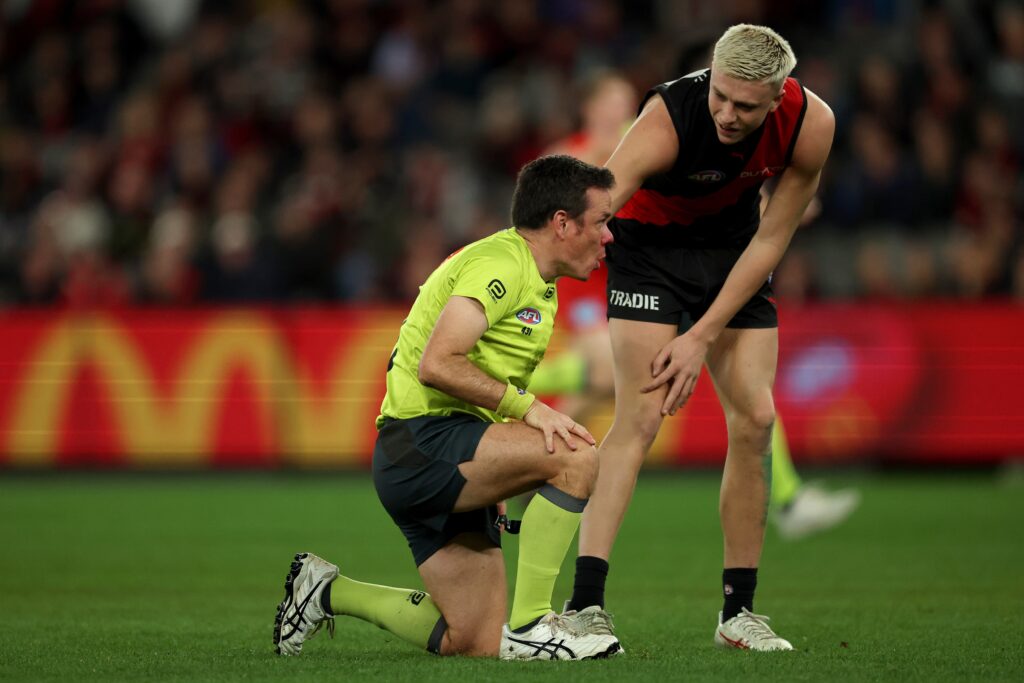
Essendon coach Brad Scott has voiced his frustration with the Australian Football League (AFL) regarding the positioning of umpires during matches, following a collision incident involving young forward Nate Caddy. The incident occurred during Essendon’s 41-point loss to Gold Coast at Marvel Stadium in Round 17, 2025, when Caddy collided with an umpire while attempting to join the contest on the opposite side of the forward 50.
Scott, who previously served as the AFL’s general manager of football, criticized the league for ignoring repeated requests to move umpires out of the corridor. He expressed disbelief that Caddy would face penalties despite recent increases in sanctions for umpire contact.
“I’ve lost count the number of times I’ve approached the AFL about moving the umpires out of the corridor. They sprint into the corridor, and they stay there, and that’s clearly where we want to get the ball,” Scott stated.
Umpire Positioning: A Point of Contention
According to Scott, the positioning of umpires in the corridor has been a persistent issue, even during his tenure at AFL House. He recounted efforts to change this practice, only to be met with resistance.
“Even when I was at the AFL, I tried to move them down the corridor and they still wouldn’t move out of the corridor. We’ve been at them and at them and at them, to move out of the corridor,” he added.
The collision with Caddy, Scott argued, was a direct result of this positioning, leading to a 15-minute delay in Caddy’s ability to rejoin the game. Scott questioned the accountability for such incidents, emphasizing that it was not the player’s fault.
Impact of the Fourth Umpire
Scott also addressed the introduction of a fourth on-field umpire, which was intended to prevent umpires from being blindsided during contests. However, he noted that the additional umpire has not resolved the issue of corridor positioning.
“[It was] so you could have an umpire on either side of the contest. Angus Clarke clearly got taken high in forward 50. The umpire on the wrong side pays holding the ball,” Scott explained.
He suggested that umpires should be positioned in quadrants outside the contest, allowing for better visibility and reducing the likelihood of collisions.
Injury Concerns and Team Adjustments
In addition to the umpire controversy, the Bombers faced injury challenges during the match. Jye Caldwell suffered an ankle injury late in the last quarter and will require scans. Winger Xavier Duursma was also under an injury cloud, leading to last-minute team adjustments.
Emergency player Elijah Tsatas was called back from a VFL game to potentially fill in, highlighting the team’s readiness to adapt amid uncertainties.
Scott commented on the situation, saying, “He had lower back spasms-slash-tightness. You can understand we’re a bit jumpy at the moment.”
Gold Coast’s Perspective
Gold Coast coach Damien Hardwick shared his own concerns regarding umpire positioning, particularly with star player Matt Rowell’s involvement in center bounces. Rowell, who was well-held by Will Setterfield, managed to lay 17 tackles during the match.
“He battles manfully, he’s a pleasure to coach and we’re so lucky to have him in our organisation,” Hardwick praised Rowell’s performance.
Hardwick acknowledged the need to protect umpires but emphasized the importance of finding solutions that do not penalize players unfairly.
He added, “There is going to be incidental contact. I think the AFL know that, I know we have to protect the umpires, but I think we’ve also got to be smart.”
Looking Ahead
As the AFL continues to navigate the complexities of umpire positioning and player safety, both teams are preparing for their upcoming matches. Essendon will focus on addressing injury concerns, while Gold Coast anticipates the return of key players for their next game against Collingwood.
The ongoing debate over umpire positioning underscores the challenges faced by the AFL in balancing the integrity of the game with player and official safety. As discussions continue, teams and officials alike will be watching closely for any changes in policy or practice.






